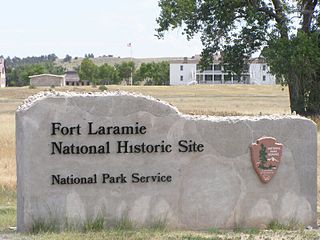 W
WThe Buffalo Bill Center of the West, formerly known as the Buffalo Bill Historical Center, is a complex of five museums and a research library featuring art and artifacts of the American West located in Cody, Wyoming. The five museums include the Buffalo Bill Museum, the Plains Indians Museum, the Whitney Western Art Museum, the Draper Natural History Museum, and the Cody Firearms Museum. Founded in 1917 to preserve the legacy and vision of Col. William F. "Buffalo Bill" Cody, the Buffalo Bill Center of the West is the oldest and most comprehensive museum complex of the West. It has been described by The New York Times as "among the nation's most remarkable museums."
 W
WFort Bridger was originally a 19th-century fur trading outpost established in 1842, on Blacks Fork of the Green River, in what is now Uinta County, Wyoming, United States. It became a vital resupply point for wagon trains on the Oregon Trail, California Trail, and Mormon Trail. The Army established a military post here in 1858 during the Utah War, until it was finally closed in 1890. A small town, Fort Bridger, Wyoming, remains near the fort and takes its name from it.
 W
WFort Caspar was a military post of the United States Army in present-day Wyoming, named after 2nd Lieutenant Caspar Collins, a U.S. Army officer who was killed in the 1865 Battle of the Platte Bridge Station against the Lakota and Cheyenne. Founded in 1859 along the banks of the North Platte River as a trading post and toll bridge on the Oregon Trail, the post was later taken over by the Army and named Platte Bridge Station to protect emigrants and the telegraph line against raids from Lakota and Cheyenne in the ongoing wars between those nations and the United States. The site of the fort, near the intersection of 13th Street and Wyoming Boulevard in Casper, Wyoming, is listed in the National Register of Historic Places and is now owned and operated by the City of Casper as the Fort Caspar Museum and Historic Site.
 W
WFort Fetterman was a wooden fort constructed in 1867 by the United States Army on the Great Plains frontier in Dakota Territory, approximately 11 miles northwest of present-day Douglas, Wyoming. Located high on the bluffs south of the North Platte River, it served as a major base for the start of several United States military expeditions against warring Native American tribes. The main role of the soldiers was to protect European-American pioneers on the Bozeman Trail. The fort is listed on the National Register of Historic Places.
 W
WFort Steele, also known as Fort Fred Steele, was established to protect the newly built Union Pacific Railroad from attacks by Native Americans during construction of the transcontinental railroad in the United States. The fort was built in 1868 where the railroad crossed the North Platte River in Carbon County, Wyoming. Work on the fort was carried out by military and civilian labor. Fort Steele was one of three forts built on the line. Fort Sanders near Laramie and Fort D.A. Russell at Cheyenne were the other railroad forts. Fort Steele was named for the recently deceased General Frederick Steele.
 W
WFort Laramie was a significant 19th-century trading post, diplomatic site, and military installation located at the confluence of the Laramie and the North Platte rivers. They joined in the upper Platte River Valley in the eastern part of the U.S. state of Wyoming. The fort was founded as a private trading post in the 1830s to service the overland fur trade; in 1849, it was purchased by the United States Army. It was located east of the long climb leading to the best and lowest crossing point of the Rocky Mountains at South Pass and became a popular stopping point for migrants on the Oregon Trail. Along with Bent's Fort on the Arkansas River, the trading post and its supporting industries and businesses were the most significant economic hub of commerce in the region.
 W
WFort Phil Kearny was an outpost of the United States Army that existed in the late 1860s in present-day northeastern Wyoming along the Bozeman Trail. Construction began Friday July 13, 1866 by Companies A, C, E and H of the 2nd Battalion, 18th Infantry, under the direction of the regimental commander and Mountain District commander Colonel Henry B. Carrington. The post was named for Maj. Gen. Philip Kearny, a popular figure in the American Civil War. The fort should be distinguished from the similarly named Fort Kearny in Nebraska, which was named for Kearny's uncle Stephen W. Kearny. Today, the fort and the nearby Fetterman and Wagon Box battle sites are maintained by the State of Wyoming as the Fort Phil Kearny State Historic Site.
 W
WThe Heart Mountain War Relocation Center, named after nearby Heart Mountain and located midway between the towns of Cody and Powell in northwest Wyoming, was one of ten concentration camps used for the internment of Japanese Americans evicted from the West Coast Exclusion Zone during World War II by executive order from President Franklin Roosevelt after the bombing of Pearl Harbor in December 1941, upon the recommendation of Lieutenant General John L. DeWitt.
 W
WThe Quebec-One Missile Alert Facility, also known as Quebec-01 or Q-01, located north of Cheyenne, Wyoming, was a United States Air Force Minuteman II ICBM launch control facility operated by the 400th Missile Squadron constructed in 1962. The facility was converted to operate the Peacekeeper ICBM in 1986. The facility was deactivated in 2005 and turned over to Wyoming State Parks in December 2017. The facility was opened to the public in August 2019 as the Quebec 01 Missile Alert Facility State Historic Site after restoration work done by the United States Air Force.